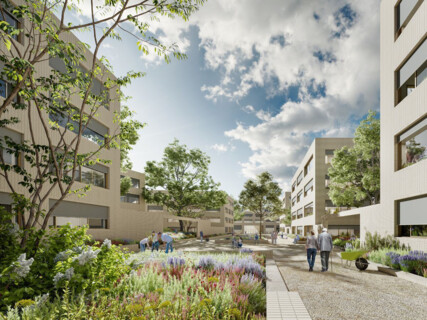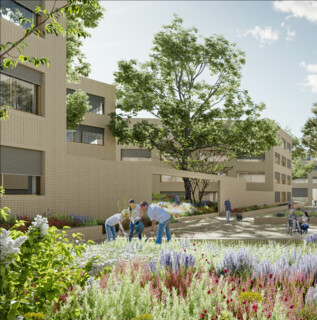- wa-ID
- wa-2030117
- Tag der Veröffentlichung
- 23.10.2020
- Aktualisiert am
- 27.10.2020
- Verfahrensart
- Einladungswettbewerb
- Teilnehmer
- Architekt*innen
- Auslober
-
IGP Projekt GmbH
Stadt Steinfurt
- Bekanntgabe
- 23.10.2020
Verfahrensart
Einladungswettbewerb
Pressemeldung von Atelier Kempe Thill, 23. Oktober 2020
ATELIER KEMPE THILL HAT KÜRZLICH EINEN EINGELADENEN WETTBEWERB FÜR EINEN MASTERPLAN EINES NEUEN GESUNDHEITSCAMPUS IN STEINFURT GEWONNEN. IN VIER CLUSTERN SOLLEN EINE 200-BETTEN-REHABILITATIONSKLINIK, EIN PFLEGEHEIM, EINE KINDERTAGESSTÄTTE UND EIN GEMEINSCHAFTSWOHNEN MIT RUND HUNDERT WOHNEINHEITEN ENTSTEHEN. SIE WERDEN GEMEINSAM EIN NEUES ENSEMBLE IN EINER GRÜNEN, AUTOFREIEN UMGEBUNG BILDEN.
Borghorst ist eine kleine Gemeinde nahe der deutsch-niederländischen Grenze in Nordrhein-Westfalen. Die Textilindustrie ließ es im neunzehnten Jahrhundert florieren. Heute ist es Teil der Stadt Steinfurt mit 34 000 Einwohnern. Neben dem Krankenhaus wurde ein Grundstück, auf dem früher eine Weberei stand, für eine Neubebauung frei. Das Atelier Kempe Thill entwarf einen Masterplan für einen Gesundheits- und Pflegecampus. Ein sehr differenziertes Programm bildete den Ausgangspunkt für diesen Vorschlag, der darauf abzielte, Menschen mit den unterschiedlichsten Bedürfnissen aufzunehmen. Das Ergebnis sind vier verschiedene Cluster, in denen jede Primärfunktion eine spezifische Gebäudetypologie aufweist. Fußgängergrüne und autofreie Achsen verbinden die verschiedenen Teile des Campus. Die 200-Betten-Rehabilitationsklinik, das Pflegeheim, das Gemeinschaftswohnen mit rund hundert Wohneinheiten und die Kindertagesstätte werden auf eigenen Baufeldern realisiert.
Die Clusterstruktur ermöglicht eine schrittweise Entwicklung des Campus und bietet genügend strukturelle Flexibilität, um bereits in der Planungsphase wirtschaftliche oder programmatische Veränderungen zu verkraften. Die Entwicklung der jeweiligen Cluster ist stufenweise möglich. Diese Strategie erlaubt es auch, zwei weitere vergleichbare Cluster auf dem zum örtlichen Krankenhaus gehörenden Grundstück auf der Südseite hinzuzufügen. Sie würden sich sowohl funktional als auch optisch leicht in den Gesundheitscampus integrieren lassen.
Diese Flexibilität untergräbt nicht die starke Identität des Gesamtprojekts. Die Cluster des Gesundheits- und Pflegecampus sind durch grüne Freiräume miteinander verbunden, die eine entscheidende Rolle bei der Schaffung von Synergien spielen. Gartenmauern bilden den kritischen Übergang zwischen öffentlichen und gemeinschaftlichen Bereichen. Und in Anlehnung an den architektonischen Stil der Region werden alle Fassadenelemente und Wegeführungen in Massivziegel ausgeführt. Daneben suchen alle neuen Baukörper in der Größe eine Verbindung zur Umgebung. Die Bebauung hat einen differenzierten und etwas offenen Charakter. Sie knüpft in Größe und Erscheinung an die Gebäude der Umgebung an und hat gleichzeitig eine klare eigene städtebauliche Gestalt.
Press release by Atelier Kempe Thill, 23 October 2020
ATELIER KEMPE THILL HAS RECENTLY WON AN INVITED COMPETITION FOR A MASTERPLAN OF A NEW HEALTH CARE CAMPUS IN STEINFURT. FOUR CLUSTERS WILL HOST A 200-BED REHABILITATION CLINIC, A NURSING HOME, A DAY CARE CENTER AND A COMMUNAL LIVING OF C. HUNDRED RESIDENTIAL UNITS. THEY WILL FORM TOGETHER A NEW ENSEMBLE IN A GREEN CAR-FREE ENVIRONMENT.
Borghorst is a little community located close to the German-Dutch border in North Rhine-Westphalia. The textile industry made it flourish in the nineteenth century. Now it's part of the city of Steinfurt counting 34 000 inhabitants. Next to the hospital, a plot where a weaving company used to stand, became free for new redevelopment. Atelier Kempe Thill designed a master plan for a health and care campus. A highly differentiated programme was the starting point of this proposal aiming to accommodate people with a wide range of needs. The result is four distinct clusters in which each primary function has a specific building typology. Pedestrian green and car-free axes connect the different parts of the campus. The 200-bed rehabilitation clinic, the nursing home, the communal living with c. hundred residential units and the daycare centre will all be realised on own building plots.
The cluster structure allows for a gradual development of the campus and offers sufficient structural flexibility to get along economic or programmatic changes during the planning phase. The development of the respective clusters is possible in stages. This strategy allows as well to add another two comparable clusters on the plot on the Southside that belongs to the local hospital. They would easily be integrated into the health campus, both in terms of function and appearance.
This flexibility doesn't undermine a strong identity of the project as a whole. The Health and Care Campus clusters are connected by green open spaces which play a crucial role in creating synergies. Garden walls shape the critical transition between public and communal areas. And following the architectural style of the region, all façade elements and pathways will be realised in solid brick. Next to that, all new building volumes seek a connection in size to the surroundings. The development has a differentiated and somewhat open character. It connects in scale and appearance to the buildings of the surroundings and has a clear own urban shape at the same time.
Einladungswettbewerb
Pressemeldung von Atelier Kempe Thill, 23. Oktober 2020
ATELIER KEMPE THILL HAT KÜRZLICH EINEN EINGELADENEN WETTBEWERB FÜR EINEN MASTERPLAN EINES NEUEN GESUNDHEITSCAMPUS IN STEINFURT GEWONNEN. IN VIER CLUSTERN SOLLEN EINE 200-BETTEN-REHABILITATIONSKLINIK, EIN PFLEGEHEIM, EINE KINDERTAGESSTÄTTE UND EIN GEMEINSCHAFTSWOHNEN MIT RUND HUNDERT WOHNEINHEITEN ENTSTEHEN. SIE WERDEN GEMEINSAM EIN NEUES ENSEMBLE IN EINER GRÜNEN, AUTOFREIEN UMGEBUNG BILDEN.
Borghorst ist eine kleine Gemeinde nahe der deutsch-niederländischen Grenze in Nordrhein-Westfalen. Die Textilindustrie ließ es im neunzehnten Jahrhundert florieren. Heute ist es Teil der Stadt Steinfurt mit 34 000 Einwohnern. Neben dem Krankenhaus wurde ein Grundstück, auf dem früher eine Weberei stand, für eine Neubebauung frei. Das Atelier Kempe Thill entwarf einen Masterplan für einen Gesundheits- und Pflegecampus. Ein sehr differenziertes Programm bildete den Ausgangspunkt für diesen Vorschlag, der darauf abzielte, Menschen mit den unterschiedlichsten Bedürfnissen aufzunehmen. Das Ergebnis sind vier verschiedene Cluster, in denen jede Primärfunktion eine spezifische Gebäudetypologie aufweist. Fußgängergrüne und autofreie Achsen verbinden die verschiedenen Teile des Campus. Die 200-Betten-Rehabilitationsklinik, das Pflegeheim, das Gemeinschaftswohnen mit rund hundert Wohneinheiten und die Kindertagesstätte werden auf eigenen Baufeldern realisiert.
Die Clusterstruktur ermöglicht eine schrittweise Entwicklung des Campus und bietet genügend strukturelle Flexibilität, um bereits in der Planungsphase wirtschaftliche oder programmatische Veränderungen zu verkraften. Die Entwicklung der jeweiligen Cluster ist stufenweise möglich. Diese Strategie erlaubt es auch, zwei weitere vergleichbare Cluster auf dem zum örtlichen Krankenhaus gehörenden Grundstück auf der Südseite hinzuzufügen. Sie würden sich sowohl funktional als auch optisch leicht in den Gesundheitscampus integrieren lassen.
Diese Flexibilität untergräbt nicht die starke Identität des Gesamtprojekts. Die Cluster des Gesundheits- und Pflegecampus sind durch grüne Freiräume miteinander verbunden, die eine entscheidende Rolle bei der Schaffung von Synergien spielen. Gartenmauern bilden den kritischen Übergang zwischen öffentlichen und gemeinschaftlichen Bereichen. Und in Anlehnung an den architektonischen Stil der Region werden alle Fassadenelemente und Wegeführungen in Massivziegel ausgeführt. Daneben suchen alle neuen Baukörper in der Größe eine Verbindung zur Umgebung. Die Bebauung hat einen differenzierten und etwas offenen Charakter. Sie knüpft in Größe und Erscheinung an die Gebäude der Umgebung an und hat gleichzeitig eine klare eigene städtebauliche Gestalt.
Press release by Atelier Kempe Thill, 23 October 2020
ATELIER KEMPE THILL HAS RECENTLY WON AN INVITED COMPETITION FOR A MASTERPLAN OF A NEW HEALTH CARE CAMPUS IN STEINFURT. FOUR CLUSTERS WILL HOST A 200-BED REHABILITATION CLINIC, A NURSING HOME, A DAY CARE CENTER AND A COMMUNAL LIVING OF C. HUNDRED RESIDENTIAL UNITS. THEY WILL FORM TOGETHER A NEW ENSEMBLE IN A GREEN CAR-FREE ENVIRONMENT.
Borghorst is a little community located close to the German-Dutch border in North Rhine-Westphalia. The textile industry made it flourish in the nineteenth century. Now it's part of the city of Steinfurt counting 34 000 inhabitants. Next to the hospital, a plot where a weaving company used to stand, became free for new redevelopment. Atelier Kempe Thill designed a master plan for a health and care campus. A highly differentiated programme was the starting point of this proposal aiming to accommodate people with a wide range of needs. The result is four distinct clusters in which each primary function has a specific building typology. Pedestrian green and car-free axes connect the different parts of the campus. The 200-bed rehabilitation clinic, the nursing home, the communal living with c. hundred residential units and the daycare centre will all be realised on own building plots.
The cluster structure allows for a gradual development of the campus and offers sufficient structural flexibility to get along economic or programmatic changes during the planning phase. The development of the respective clusters is possible in stages. This strategy allows as well to add another two comparable clusters on the plot on the Southside that belongs to the local hospital. They would easily be integrated into the health campus, both in terms of function and appearance.
This flexibility doesn't undermine a strong identity of the project as a whole. The Health and Care Campus clusters are connected by green open spaces which play a crucial role in creating synergies. Garden walls shape the critical transition between public and communal areas. And following the architectural style of the region, all façade elements and pathways will be realised in solid brick. Next to that, all new building volumes seek a connection in size to the surroundings. The development has a differentiated and somewhat open character. It connects in scale and appearance to the buildings of the surroundings and has a clear own urban shape at the same time.






